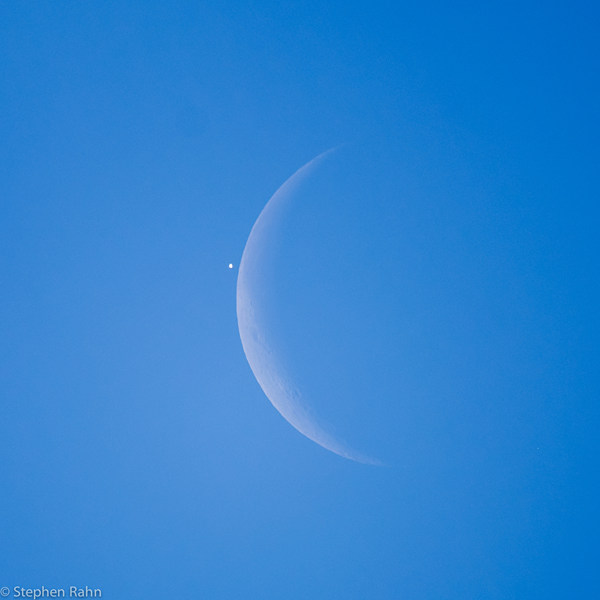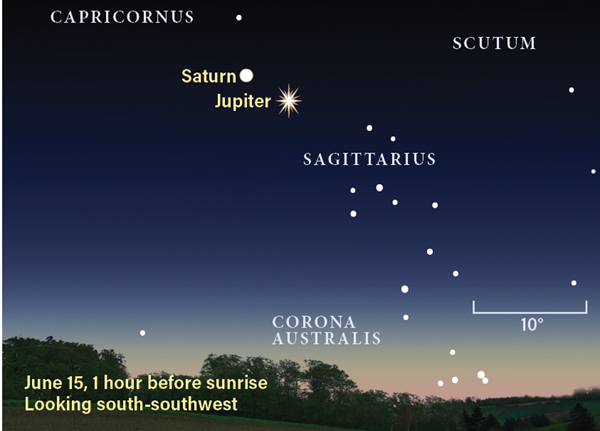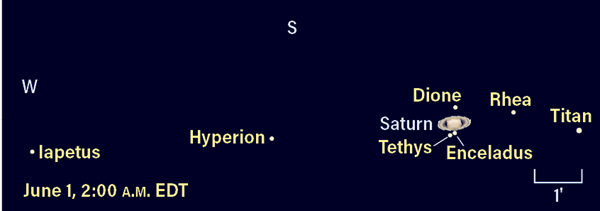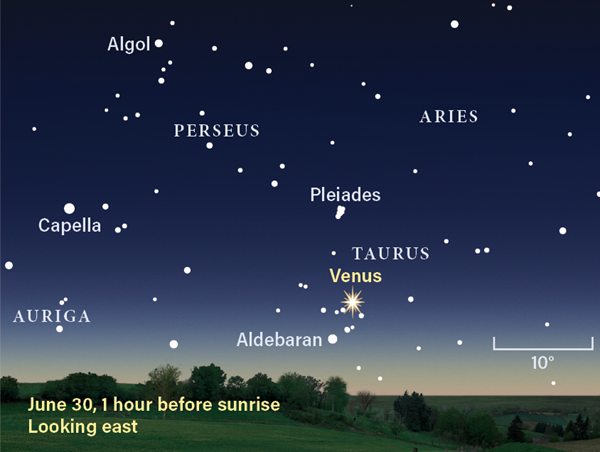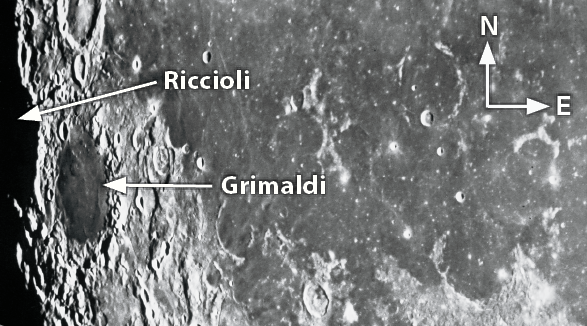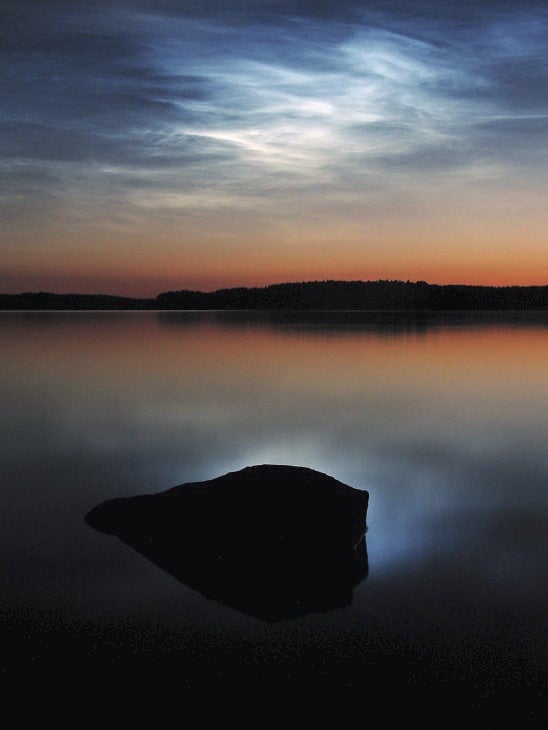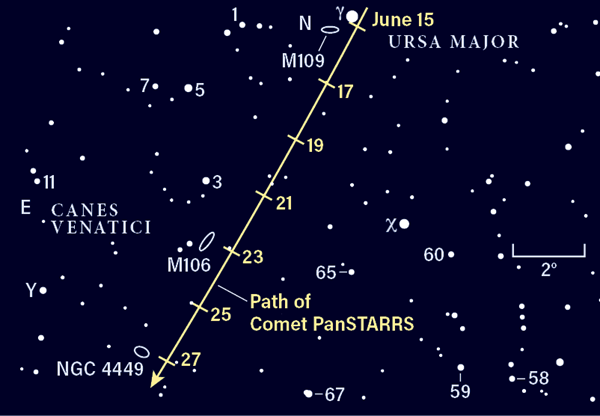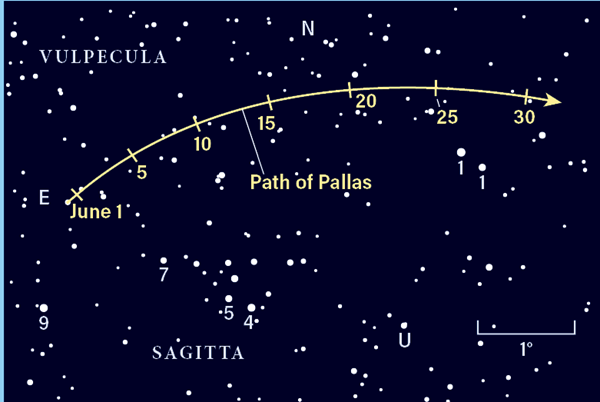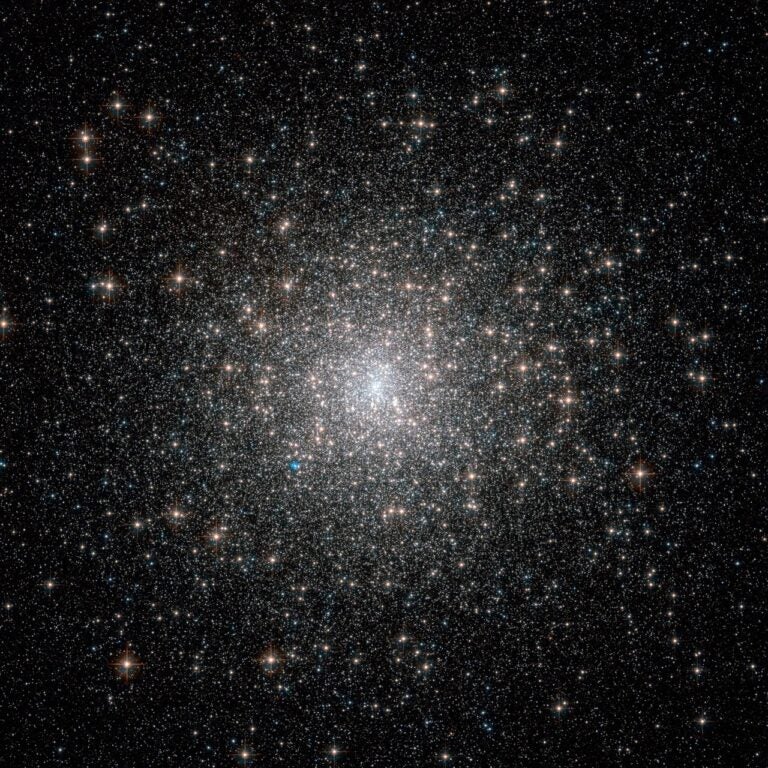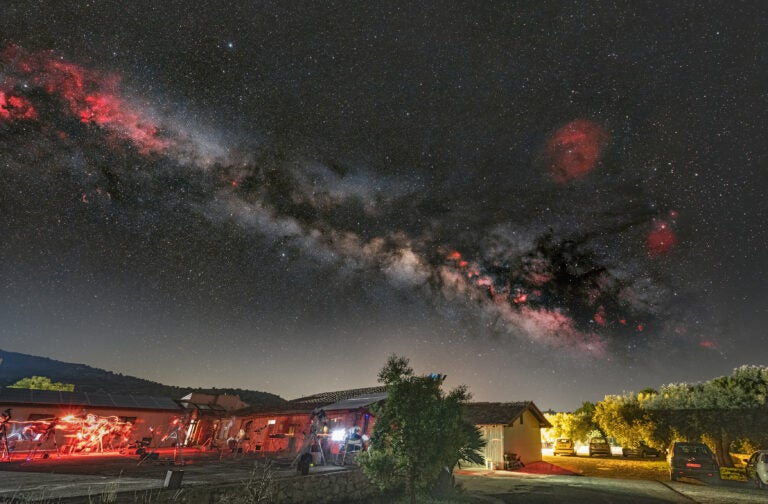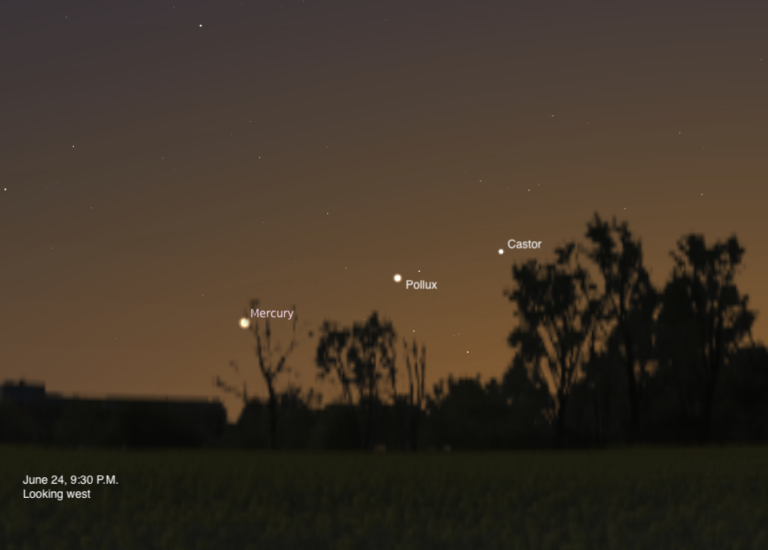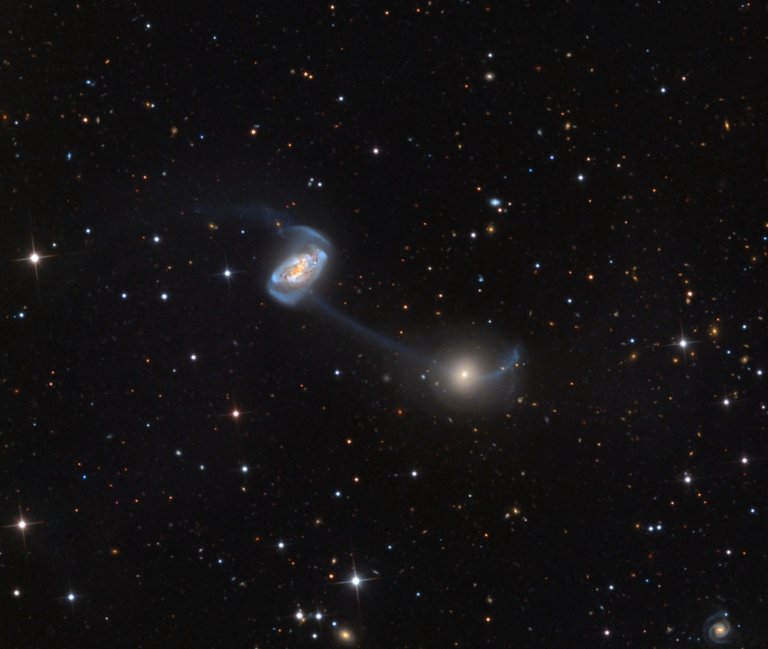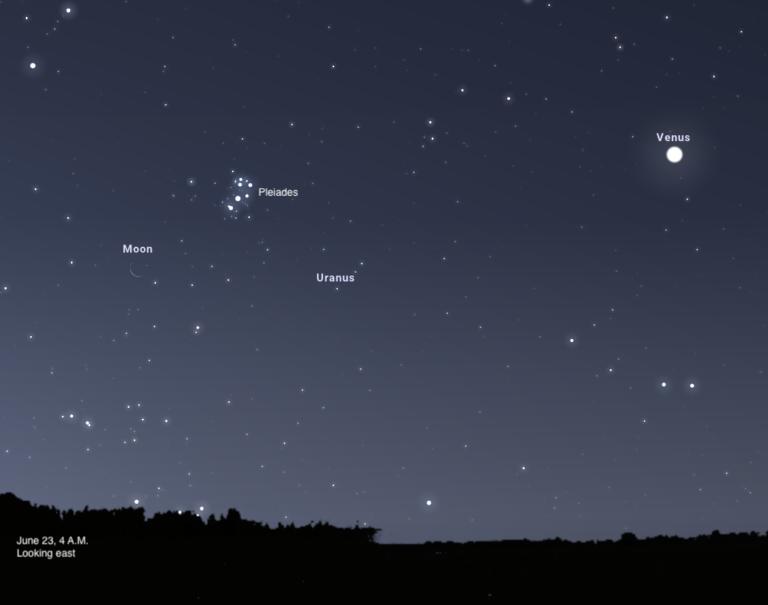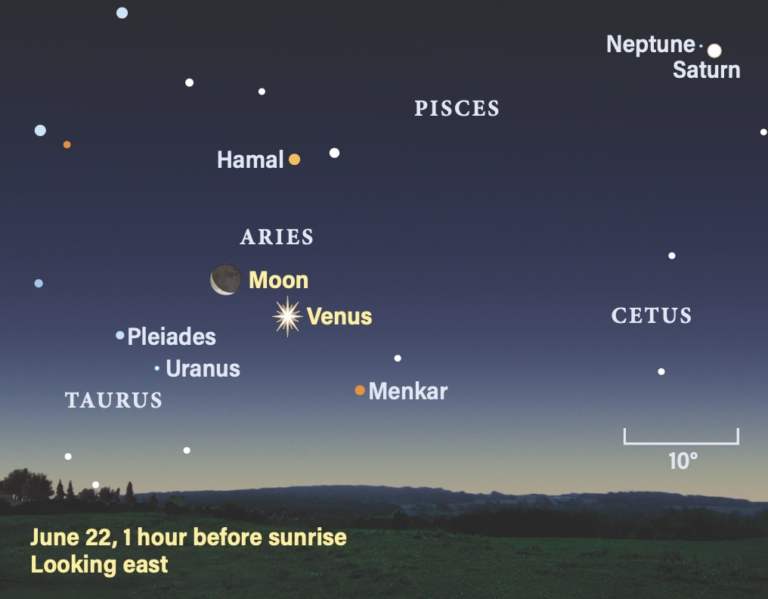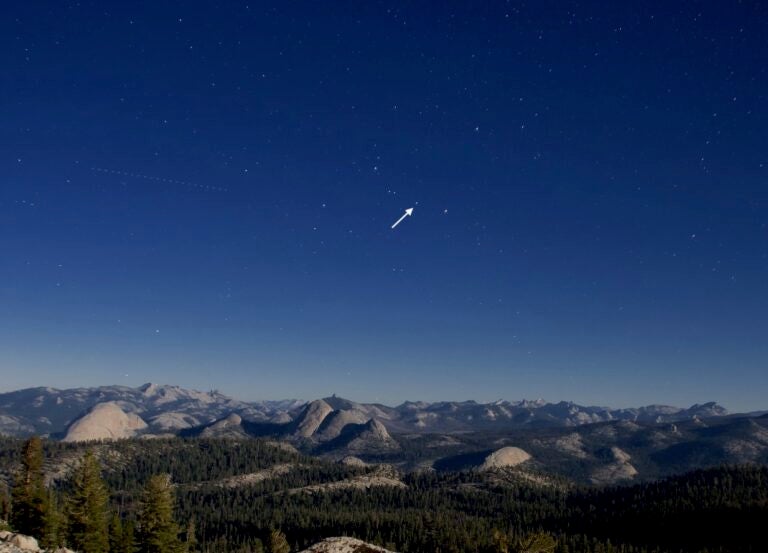Mercury is well placed for U.S. observers during the first two weeks of June as it climbs to its June 4 greatest eastern elongation (24°), set against the backdrop of Gemini the Twins. In twilight, the twins’ brightest stars, magnitude 1 Castor and Pollux, stand out an hour after sunset when you look west.
On June 1, Mercury shines at magnitude 0.1 and fades to 1.4 by June 13, when it stands 11° below Pollux. On June 4, Mercury sets nearly two hours after the Sun, providing ample opportunity to view the innermost planet. Try to spot the tiny 8″-wide disk in your telescope — it’s challenging at the planet’s low altitude (7° one hour after sunset for latitudes near 40° north). The disk is 36 percent lit and drops to a 19 percent illuminated crescent by June 13. That narrowing crescent increases in angular size, reaching 10″ on the same date.
Mercury fades and sets earlier each evening, making it progressively harder to spot in mid-June. It dims to 2nd magnitude and is just 3° high 45 minutes after sunset on June 16.
On June 1, Jupiter lies 4.8° west of Saturn. By June 30, that gap has increased to 6°. Jupiter begins the month at magnitude –2.6 and brightens to –2.7 by June 30. Soak in the remarkable view through 7×50 binoculars. The scene captures not only the solar system’s two largest planets, but also M75, a globular cluster 68,000 light-years away and orbiting our Milky Way Galaxy. It’s a faint, fuzzy object shining at magnitude 9.5 and lying 1.5° south of the line joining Jupiter and Saturn.
The best views of both planets occur in the hours before dawn, when they stand about 30° high from a latitude of 40° north. By the end of June, they’re well above the horizon an hour or two after local midnight.
Telescopic views reveal Jupiter’s 45″-wide disk, which grows to 46.6″ by the end of the month. If the atmosphere above your observing site is steady, you’ll be treated to spectacular views of its belts and zones, and occasionally the Great Red Spot. All features rotate in under 10 hours, so changes in appearance are noticeable over a 15-minute period. Jupiter’s brilliance can hide subtle features if you take a quick glance — relax your eye and gaze for a minute or so to become accustomed to the majestic view.
The four Galilean moons offer a continually varying display, appearing east and west of the planet. Most interesting is when the moons pass in front of or behind the planet in occultations, eclipses, and transits.
Multiple events can occur within minutes of each other. The relative placements of Jupiter, its shadow, the moons, and their respective shadows offer a unique appreciation of the dynamic three-dimensional nature of the entire system as these events progress.
One multiple-moon event occurs on the night of June 13/14, when Callisto is eclipsed by Jupiter’s shadow beginning at 1:17 A.M. EDT, just as Io’s shadow begins to transit. Note that Callisto is visible at first almost 1′ west of Jupiter (approximately two jovian disk diameters away) and fades over a 10-minute period. The following night, Ganymede is eclipsed on June 14/15 at 12:40 A.M. EDT, while Europa and its shadow are transiting the disk of the planet.
Pluto sits less than 2° southwest of Jupiter’s location. At magnitude 14.7, it is a difficult challenge — within reach of imaging but beyond visual observers. On June 1, Pluto lies a mere 4′ due south of a 9th-magnitude field star, HIP 97251. By June 20, Pluto wanders west near a grouping of about nine 10th- and 11th-magnitude field stars that form a small oval-shaped collection about 1/3° across. By June 29, Pluto lies 41.3′ due south of Jupiter.
Farther from the rings are Tethys, Dione, and Rhea, shining between 10th and 11th magnitude, and orbiting with periods from 1.9 to 4.5 days. Titan, the brightest moon, orbits every 16 days and shines at magnitude 8.8. You’ll find it due north of Saturn June 14 and 30, and due south June 6 and 22.
More distant Iapetus varies in brilliance between eastern and western elongations. It’s brightest (magnitude 10.2) 9′ due west of Saturn on June 1, just a day after its western elongation. At this position the brighter of Iapetus’ two hemispheres faces Earth. Throughout June it tracks closer to Saturn and reaches superior conjunction June 20, 54″ north of Saturn and near magnitude 11.
Mars rises soon after 2 A.M. local time on June 1 and an hour earlier by June 30. It’s located in Aquarius, brightening from magnitude 0 to –0.5 in the pre-dawn sky this month. The Red Planet is now only four months away from opposition. The best time to view it is in the hour before dawn. At 4 A.M. local time, Mars stands only 20° high on June 1, but 30° high at the same time on June 30 — higher than its 2018 opposition.
Mars begins June at 9″ in apparent diameter, and grows to 11″ by June 19. Telescopes reveal a distinctive gibbous disk 84 percent lit. Visually, its features remain a challenge, requiring 8- to 10-inch scopes under good conditions. Video-frame capture opens Mars observing to smaller instruments, as does boosting the magnification with a Barlow lens. In the hour before dawn during June’s first two weeks, you may spot the Tharsis ridge volcano region and the Mariner Valley. By late June, the distinctive dark Syrtis Major is evident.
Neptune is also in Aquarius and stands 1.8° due north of Mars on June 12. Observers can easily swing to Neptune with a scope and spy its 2.3″ bluish disk, which lies 30 times farther than Mars (which is at 0.9 astronomical unit from Earth, or nearly 84 million miles).
The outer planet lingers while Mars drifts past over a few days. At magnitude 7.9, Neptune can be picked out with binoculars 3.5° east of Phi (φ) Aquarii. Just over a degree east of this star is a pair of 6th-magnitude stars roughly aligned north-south. Another 2° farther lies a second 6th-magnitude star, forming a long triangle with the previous pair. Neptune lies a Moon-width short of this star. For most of June, it drifts slightly eastward before reaching a stationary point June 23.
Uranus lies in Aries the Ram and rises in the hour before the onset of twilight. It stands about 10° high June 16, a waning crescent Moon nearby. Uranus, at magnitude 5.9, lies 10° left of the Moon and both are visible at 4:30 A.M. local time. In the dawn sky of June 17, Uranus lies 5° north of the thinning crescent. The rapidly advancing twilight hides Uranus quickly — viewing improves next month.
Venus leaps into the morning sky in late June following its inferior conjunction with the Sun on June 3. It misses the Sun by just 0.2°. See how soon after conjunction you can spot it low in the east-northeast. By June 18, Venus lies 11° east of a 27-day thin crescent Moon. Venus is 4° high 45 minutes before sunrise and glowing at magnitude –4.3.

Our exclusive Sky Guide 2020 is now available! This free downloadable pamphlet contains a month-by-month rundown of 2020’s biggest celestial events, from Mars’ best opposition in years to the return of totality in South America this December. Check out Astronomy’s Sky Guide 2020 now!
By June 30, Venus is 8° high an hour before sunrise, located near the Hyades star cluster and 4.5° northwest of Aldebaran, the 1st-magnitude star in Taurus the Bull. The Pleiades (M45) stand 10° above the planet.
The Moon continues along the ecliptic to occult the Sun on June 21 in an annular eclipse visible from Africa, the Arabian Peninsula, Pakistan, northern India, China, and Taiwan. Greatest eclipse occurs near the India-China border with a 38-second duration and 99 percent coverage, resulting in a very thin annular ring. Guam is just outside the path of annularity and experiences a 98 percent eclipsed Sun near sunset.
The summer solstice occurs on June 20 at 5:44 P.M. EDT.
Rising Moon: Westward ho
The lava-filled Grimaldi basin is easily identified on the western limb of the Moon as the last patch of dark mare west of the huge Oceanus Procellarum. Fully illuminated on June 4, the highly battered crater rim is direct evidence of its age. Several interesting sights have also appeared next to Grimaldi, notably the equally large and battered Riccioli closer to the terminator. That crater has a much rougher floor because it was a little too far from Procellarum’s lava floods to get filled up like Grimaldi.
Use a dark filter on your eyepiece to reduce the stark brightness levels of this nearly Full Moon. If you don’t have one, just crank up the power to spread out the light and you’ll find it a lot easier on the eye. Spend some time here to note that Grimaldi’s basin floor is not a uniform shade. See if you can follow the indistinct rays of lighter rock back to their source, ejected from a couple of major impacts late in the Moon’s bombardment.
You can see Grimaldi in a completely different light on Thursday morning, the 18th, when the Moon is a gorgeous crescent floating above Venus. While the rest of the face is bathed in earthshine, Grimaldi is a snap to spot as a sharply defined dark ellipse. The cycle almost repeats one lunation later, with lunar sunrise recurring on the evening of July 4.
Meteor watch: Clear nights with daytime showers
No major meteor showers occur in June. A few daytime showers are active in the first week of the month, of possible interest to radio observers. These are the Arietids and Zeta Perseids. Later in the month, the Boötid meteor shower is active from June 22 to July 7, peaking on June 27. Boötes is visible most of the night, although rates have been quiescent except for a reported outburst in 1998.
The summer season sets up conditions to produce noctilucent (night-glowing) clouds, formed by ice crystals on high-flying dust particles. Their pearly white appearance remains sunlit long after regular clouds darken in the deepening twilight because they occur 50 miles up — more than 10 times the height of cirrus clouds. They are best seen from latitudes between 55° and 70° north.
Comet search: PanSTARRS pairings
The fantastic photo ops of comet and deep sky continue, and timing with the New Moon couldn’t be better. In case you didn’t get last month’s issue, on May 22 and 23 Comet PanSTARRS (C/2017 T2) joined the great galaxies Messier 81 and 82. By chance, during the Full Moon on June 5, the comet floats through the uninteresting bowl of the Big Dipper, then it poses less than a degree from M109 on the night of the 16th. The Moon doesn’t even rise until twilight begins — what good luck.
T2 has just passed its peak brightness but should still be roughly 8th magnitude as it shares the field with the grand and picturesque bright spiral galaxy M106 on the night of the 23rd. Since you’re taking advantage of mild summer conditions by observing all night on the weekend of the 27th, see the comet near NGC 4449 after moonset.
Visually these galaxy-comet duos deserve prolonged inspection. Notice how their shapes are different. The galaxies are symmetrical ovals, whereas the comet will be quite lopsided with its bright, round-edged coma on one side and a flat, diffuse fan of a tail on the other. Take your time, push the power past 150x on a 6-inch and 300x on a 12-inch scope. Although it makes the view darker, the larger image scale allows your averted vision to pick out structure in both objects.
Imagers will be delighted by the difference between T2’s green coma and the pink-red color of the galaxies’ star-forming regions. But will the comet’s white dust tail be long enough to drape across the distant starlight of these island universes? Let us know.
Locating asteroids: Crossing the Great Rift
You won’t have to be sly to track 2 Pallas across the territory of Vulpecula, the celestial fox. With a 4- or 6-inch scope from the suburbs, you can nab this main-belt asteroid by dropping south of the lovely double star Albireo, or by scooting north of the Coathanger asterism, all climbing higher in the eastern sky.
The background sky here is not crammed with stars, thanks to all the obscuring dust and gas that together form the Great Rift in the Milky Way. This will make it easier to locate and follow the modest magnitude 10 glow of Pallas. Still, you will want to push the power past 100x in order to separate the pinprick of light from any nearby stars on the chart. After you find Pallas, shift your scope east to see the Milky Way spill into view.
With the generally good weather in June, you can likely observe three evenings in a given block of five, giving you the chance to watch the night-to-night shift of Pallas. June 9 to 13 is ideal, since one field of view contains more than a half-dozen stars to use as reference markers. Just jot down a few points on a logbook page, then keep coming back to discover which dot has moved. We’re so far from the path of the Moon that its light will not bother us.
Pallas is one of the few asteroids with an inclination high enough to take it well above the throngs orbiting closer to the ecliptic plane. Heinrich Olbers discovered it by accident in 1802 when it happened to be near Ceres. If not for that, Pallas would have been found later and assigned a higher number.

